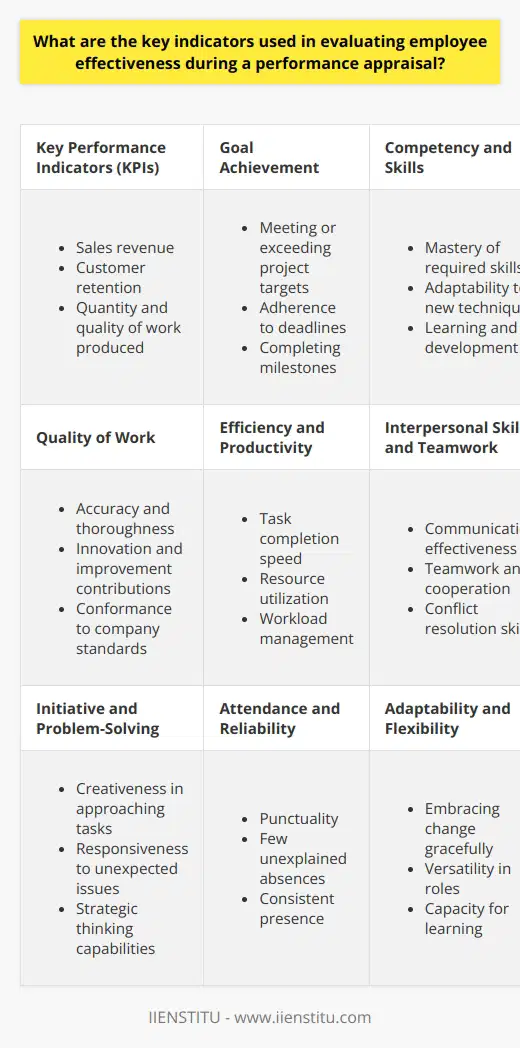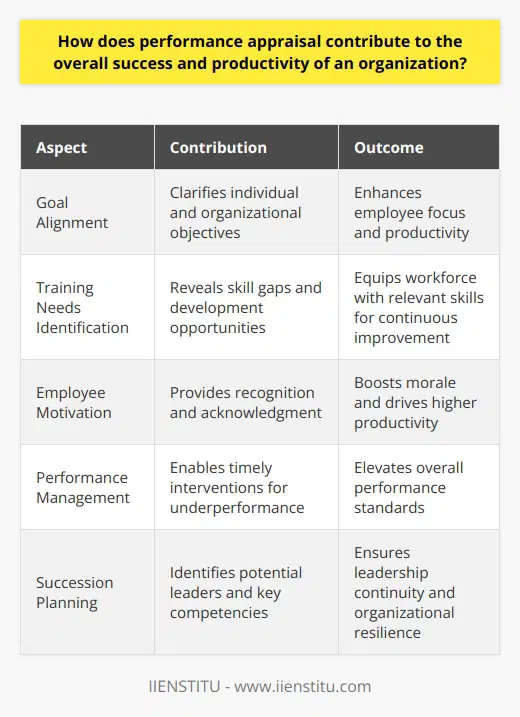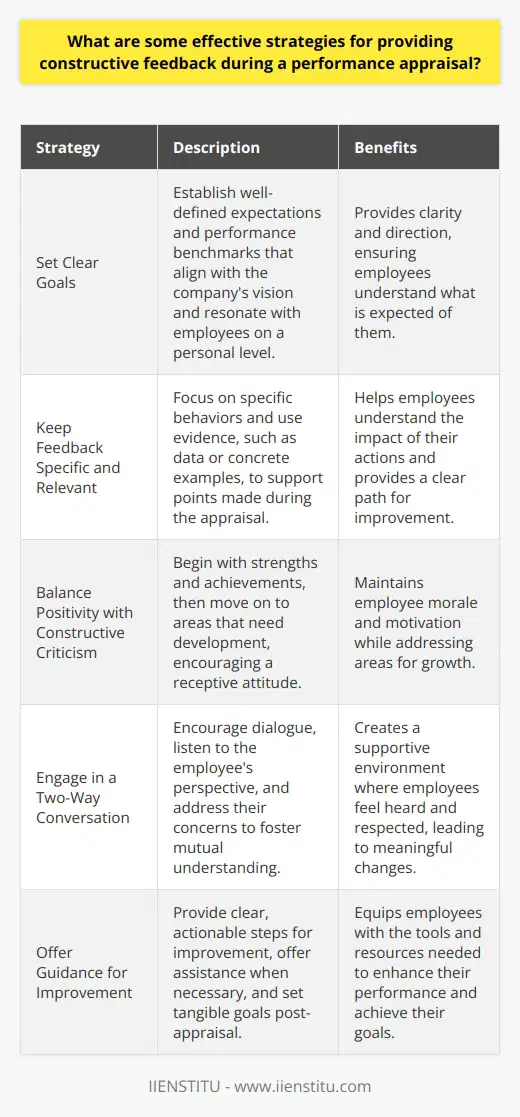
Performance appraisal constitutes a foundational aspect of human resources management, encapsulating the systematic and structured process by which the performance of employees is reviewed and assessed. This practice serves not only as a metric for judging effectiveness but also as a strategic tool to enhance productivity and align individual objectives with the broader organizational goals.
In this comprehensive examination of performance appraisal methods, key functions, and evolving trends, we will explore how this mechanism is instrumental in promoting employee development and ensuring the competitive edge of a business.
I. Introduction
A. Definition of Performance Appraisal
Performance appraisal is a methodical approach that involves evaluating an individual employee's job performance and productivity in relation to certain pre-established criteria and organizational objectives. It is an enduring human resources practice intended to measure, comprehend, and enhance employee performance while also aiding in administrative decisions made by the organization.
The process typically involves observing, documenting, and analyzing an employee’s work, behaviors, and results against expected deliverables and role responsibilities.
B. Importance of Performance Appraisal
The significance of effectively conducted performance appraisals extends far beyond the plain assessment of an employee's competence. It is pivotal for identifying strengths that can be harnessed and weaknesses that may necessitate targeted intervention through a human resources course or online certification courses.
Such appraisals offer insights into employee potential, fostering opportunities for personal and professional development within the workplace. Moreover, they establish a culture of transparency, accountability, and continuous improvement, while also providing the groundwork for fair and justifiable compensation practices.
II. Understanding Performance Appraisal
360-Degree Feedback: An In-depth Analysis of Its Implications & Impact
HR Auditing: Comprehensive Insight into Organizational Assessment
HR Research: Decoding the Imperative Role in Organizational Success
A. History and Evolution of Performance Appraisal
Tracing back to the early 20th century, performance appraisal has undergone a transformation, evolving from basic systems of merit rating to sophisticated, multifaceted processes. It initially focused on attributing a worker's output strictly to personal effort and ability, overlooking systemic and environmental influences.
Over time, performance appraisals have been refined to appreciate the complex web of factors affecting employee behavior and productivity, taking a more holistic and integrative view.
B. Different Methods of Performance Appraisal
Performance appraisal methodologies can be broadly categorized into traditional and modern approaches, each with its own set of techniques and measures.
1. Traditional Methods
Traditional methods of performance appraisal include tools like rating scales, checklists, and forced distribution, emphasizing quantifiable aspects of performance. The scale method, for instance, rates employees on various job dimensions to provide a composite score of their overall effectiveness. Such methods are straightforward, however, often limited in their ability to capture the nuanced and qualitative components of job performance.
2. Modern Methods
Modern methods such as 360-degree feedback, Management by Objectives (MBO), and behaviorally anchored rating scales (BARS) prioritize the involvement of multiple stakeholders to assess performance, and stress the alignment of individual goals with organizational objectives. These contemporary approaches harness robust feedback mechanisms and goal-setting frameworks to offer more rounded and actionable evaluations.
III. Steps Involved in the Performance Appraisal Process
A. Goal Setting
The commencement of the performance appraisal process involves setting transparent and challenging yet attainable goals. Well-defined objectives provide clear direction and furnish benchmarks against which performance can be measured. Goal-setting theories, notably advanced by scholars like Gary Latham, underscore the motivational effects of goal specificity and difficulty within the context of achieving measurable outcomes.
B. Performance Measurement
The measurement phase is crucial, as it entails the pragmatic evaluation of the employee's work against the goals established. This involves gathering and analyzing data which could be sales figures, customer service ratings, punctuality records, or other job-specific metrics that offer tangible evidence of performance levels.
C. Feedback and Communication
Subsequent to measuring performance, the provision of constructive feedback embodying commendations for strengths and guidance on areas for improvement is essential. Communication must be clear, candid, and amenable, establishing a two-way dialogue that encourages the employee to engage with their appraisal actively.
D. Decision Making on Performance Outcomes
Based on the overall appraisal, decisions pertaining to promotions, increments, bonuses, training needs, or, in some cases, terminations are made. Such outcomes are directly tied to the employee's observed performance and future potential, ensuring that merit forms the cornerstone of all consequential decisions.
IV. Key Functions of Performance Appraisal
A. Evaluation of Employee Performance
Performance appraisals serve as an operational tool to ascertain the level of employee achievement. By providing insights into where an employee excels or requires additional support, appraisal data underpin the management's ability to make informed decisions about employee utilization, task assignment, and resource allocation.
B. Employee Development and Training Needs
Unlocking the diagnostic function of performance appraisals illuminates the specific developmental needs of employees. It enables organizations to tailor training programs, such as online certification courses, to fill skill gaps and enhance employee capabilities, ensuring the workforce’s alignment with evolving job demands.
C. Succession Planning
Evaluating employee effectiveness also assists in determining leadership potential and readiness for higher responsibilities. Through this, performance appraisals can inform succession planning, ensuring that there is a pipeline of competent candidates ready to step into critical roles when required.
D. Compensation Decisions
Compensation strategies are often closely tied to the outcomes of performance appraisals. By employing a systematic approach to evaluating performance, organizations can administer pay raises, bonuses, and other incentives with fairness and precision, thereby reflecting an employee's true contribution to corporate objectives.
V. The Role of Performance Appraisal in Employee Motivation
A. Recognition and Rewards
Performance appraisals are integral in validating an employee's hard work and achievements. Recognition conveyed through appraisals acts as a powerful motivator, enhancing an employee’s engagement and loyalty to the organization. Rewards linked to appraisal outcomes can have similar effects, incentivizing performance and fostering a high-performance culture.
B. Improvement in Job Performance
By highlighting behavioral expectations and providing constructive feedback, performance appraisals can incentivize employees to strive for continuous improvement in their job performance. This ongoing process of refinement ensures that employees are not resting on their laurels but are actively seeking ways to enhance their effectiveness and productivity.
C. Career Development Opportunities
Appraisals often uncover latent talents and identify areas for career advancement. Employees are thus empowered with information and prospects for progressing within their field, which can ascribe a sense of progression and upward mobility, driving motivation and job satisfaction.
VI. The Challenges in Performance Appraisal
A. Subjectivity and Bias in Appraisals
Despite the best of intentions, performance appraisals are vulnerable to subjectivity and personal biases. Appraisers may harbor conscious or unconscious preferences that can distort appraisal outcomes, calling into question the fairness and accuracy of the evaluation.
B. Inadequate Training of Appraisers
The effectiveness of performance appraisals is largely dependent on the capabilities of the appraiser. Without proper training, assessors might fail to conduct appraisals proficiently, leading to unreliable and inconsistent results that could have detrimental effects on employee morale and organizational health.
C. Poor Communication and Feedback Practices
A performance appraisal process that suffers from poor communication can undermine the outcomes of the appraisal. Feedback that is not timely, specific, or actionable can fail to provide employees with the guidance they need to improve, resulting in confusion and frustration.
VII. Performance Appraisal Trends for the Future
A. Increased Use of Technology
The future of performance appraisal may hinge on the integration of sophisticated technologies such as artificial intelligence (AI) and analytics. These innovations offer the potential for more unbiased, consistent appraisals and real-time feedback, which could transform how performance is measured and managed.
B. Shift towards Developmental Appraisals
There is also a growing trend toward performance appraisals that are less about formal judgment and more about ongoing development. This progressive view considers the appraisal process as a continuous dialogue and partnership between employees and management, focusing on growth rather than mere evaluation.
VIII. Reflecting on Performance Appraisal Practices and Suggestions for Improvement
In conclusion, performance appraisals are a lynchpin in achieving organizational success and enhancing employee engagement. When conducted with meticulous care and constant refinement, they provide vital insights into employee performance, endorse a culture of meritocracy, and become an indispensable tool for strategic human resources management. Organizations should make concerted efforts to mitigate challenges associated with appraisals and embrace future trends that advocate for technological enhancements and a developmental ethos. In doing so, they will maximize their most valuable asset – their people – thus solidifying the foundation for sustained success and innovation in the competitive business landscape.
Frequently Asked Questions
What are the key indicators used in evaluating employee effectiveness during a performance appraisal?
Evaluating Employee Effectiveness
Evaluating employee effectiveness involves multiple indicators. These indicators offer insights into performance.
Key Performance Indicators (KPIs)
KPIs are quantifiable measures. They reflect the critical success factors of an organization. Organizations often set these metrics in relation to industry standards.
KPIs may include:
- Sales revenue
- Customer retention
- Quantity and quality of work produced
Goal Achievement
Evaluating goals is essential. The assessment of goal alignment and achievement is critical. Goals provide clear directives for success.
This can cover:
- Meeting or exceeding project targets
- Adherence to deadlines
- Completing milestones
Competency and Skills
Competencies and skills stand as crucial indicators. They showcase the ability to perform job-specific functions. Technical proficiency is key, reflecting actual ability.
Consider the following:
- Mastery of required skills
- Adaptability to new techniques
- Learning and development
Quality of Work
Quality becomes a significant factor. It is indicative of one's attention to detail. High standards maintain organizational reputation.
Quality assessment includes:
- Accuracy and thoroughness
- Innovation and improvement contributions
- Conformance to company standards
Efficiency and Productivity
Efficiency refers to the use of resources. Productivity measures output. Effective employees use less to do more.
Indicators are:
- Task completion speed
- Resource utilization
- Workload management
Interpersonal Skills and Teamwork
Collaboration breeds success. Employees must work well in teams. Interpersonal skills enhance collective achievement.
Areas to review:
- Communication effectiveness
- Teamwork and cooperation
- Conflict resolution skills
Initiative and Problem-Solving
Taking the initiative signals proactive behavior. Problem-solving reflects analytical skills. Employees must navigate challenges effectively.
Key aspects include:
- Creativeness in approaching tasks
- Responsiveness to unexpected issues
- Strategic thinking capabilities
Attendance and Reliability
Reliability is non-negotiable. Attendance records speak to commitment. Regular attendance correlates to dependability.
Points of interest:
- Punctuality
- Few unexplained absences
- Consistent presence
Adaptability and Flexibility
Adaptability is critical in a dynamic work environment. Flexibility allows for seamless transition through change. Employees must adjust and evolve.
This encompasses:
- Embracing change gracefully
- Versatility in roles
- Capacity for learning
Manager and Peer Feedback
Feedback illustrates perceived effectiveness. Both manager and peer insights are invaluable. They provide holistic views of performance.
Feedback elements are:
- Reviews from immediate supervisors
- Peer evaluations
- Self-assessment reflections
Conclusion
These indicators map out comprehensive employee appraisals. Together, they offer a structured approach to evaluating effectiveness. Employers and employees gain from such detailed assessments.

How does performance appraisal contribute to the overall success and productivity of an organization?
Performance Appraisal: A Catalyst for Success
Organizational success hinges on productivity and efficiency. Performance appraisal stands as a pivotal practice. It yields detailed insights into employee accomplishments. Clearly, it underpins effective human resource management.
Aligning Goals and Expectations
It fosters alignment between individual and organizational goals. Employees understand what the organization values through this process. They receive feedback on their contributions and performance. This clarity enhances their focus on key objectives.
Identification of Training Needs
Performance reviews reveal individual training needs. Organizations can tailor development programs effectively. This results in a workforce equipped with relevant skills. Such targeted training ensures continual improvement and adaptability.
Motivating Employees
Positive recognition through appraisals boosts employee morale. Employees feel valued and acknowledged. This recognition often translates into increased motivation. A motivated workforce invariably pushes productivity upward.
Facilitating Communication
Appraisal systems encourage open dialogue. Employers and employees engage in constructive exchanges. This two-way communication strengthens relationships. It also ensures that concerns and ideas are freely shared.
Succession Planning
Appraisals help identify potential leaders. They provide a clear picture of competencies and strengths. Organizations can thus plan for leadership continuity. Succession planning is critical for long-term organizational resilience.
Managing Performance
Effective appraisals enable better performance management. Employers can address underperformance promptly. Timely interventions prevent issues from escalating. Consequently, the overall performance standard improves.
Setting and Tracking Goals
Reviews typically involve goal setting for future performance. Goals are specific, measurable, and time-bound. Employees have clear targets to aim for. Tracking progress towards these goals becomes systematic.
In conclusion, performance appraisal is indispensable. It contributes substantially to organizational success and productivity. This system supports goal alignment, skills development, and motivation. It also enhances communication and aids in succession planning. Organizations thereby foster a culture of continuous improvement. Embrace performance reviews for a thriving workforce.

What are some effective strategies for providing constructive feedback during a performance appraisal?
Understanding Constructive Feedback
Constructive feedback serves as a cornerstone for employee growth. At its core, it aims to encourage improvement rather than to criticize. But how do we ensure that feedback fuels development during a performance appraisal effectively? The following strategies can be highly effective.
Start with Clear Goals
Set clear expectations from the outset. Ensure employees understand performance benchmarks. Goals should align with the company’s vision. They should also resonate on a personal level with each employee.
Keep Feedback Specific and Relevant
Focus on specific behaviors rather than attributes. General comments foster confusion, not clarity. Use evidence to highlight points made. This might include data or concrete examples of work.
Balance Positivity with Constructive Criticism
Ensure feedback includes both positives and areas for improvement. Start with strengths. Recognize achievements and effort. Then, move onto aspects that need development. This approach encourages a receptive attitude.
Use the Sandwich Method
The sandwich method has gained popularity. Start with positive feedback. Add in criticism. End on a positive note again. This technique helps soften the blow of critique.
Engage in a Two-Way Conversation
Encourage dialogue. Listen to the employee’s perspective. Address their concerns. They should feel heard and respected. Mutual understanding paves the way for meaningful changes.
Offer Guidance for Improvement
Provide clear, actionable steps for betterment. Offer help where necessary. Provide resources or training if needed. Set up tangible goals post-appraisal.
Follow-up on Progress
Regular follow-ups show ongoing commitment. They also help keep goals on track. Celebrate improvements. Address lingering issues promptly.
Ensure Consistency
Be consistent with all employees. Use the same criteria for evaluation. This shows fairness and reduces bias.
Keep it Professional and Respectful
Always maintain professionalism. Personal remarks are off limits. Frame feedback in a way that respects the individual’s dignity.
Avoid Comparison with Others
Compare employees against standards, not each other. Comparisons can foster unwanted competition. They also detract from personal growth focus.
Prepare and Practice
Preparation is key to effective delivery. Anticipate reactions. Craft responses in advance. Consider potential questions. Practice makes the appraisal smoother.
Using these strategies, appraisals turn into growth opportunities. They foster an atmosphere of continuous improvement. Both employees and the organization can benefit from such a dynamic of constructive exchange.



